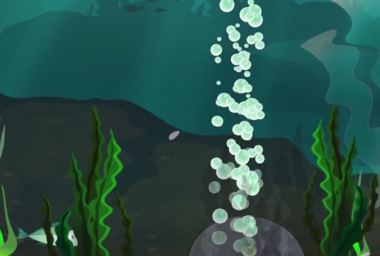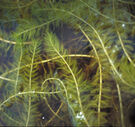
Dugouts provide water for a wide variety of farm uses, including domestic supplies, livestock watering, crop spraying and more. Aeration is generally accepted as an inexpensive way to improve dugout water quality. This article debunks some of the most common myths about dugout aeration.
The Fact is: A diffuser dramatically increases the effectiveness of any aeration system. Oxygen levels in dugouts aerated with a diffuser are twice as high as those in dugouts aerated without a diffuser. A diffuser is relatively inexpensive compared to the cost of a compressor, and by including it as part of your aeration system, you can improve your dugout's water quality significantly.
The Fact is: Placing the diffuser on the bottom of the dugout at its deepest point produces the best aeration and the highest quality water. Diffusers do not mix water located below their elevation, and since sediments release nutrients when they come in contact with poor quality water, the diffuser should be located in the deepest part of the dugout.
The Fact is: The placement of the diffuser does not need be located near the intake. If the aeration system is working properly, the water in the dugout will be well mixed and uniform in quality regardless of the diffusers proximity to the intake.
The Fact is: While it may be possible to get away with aerating only at night, or for part of each day, aeration systems produce the best results when operated 24 hours per day. Aeration systems operate longer and are more trouble free when they are operated continuously. Turning the system on and off produces wear and tear on the compressor and the motor and will ultimately shorten the lifespan of these running parts. In the long run, this wear and tear will cost more than the energy required to operate the system 24 hours per day.
The Fact is: Aeration can also improve water quality during the summer. By maintaining a high level of oxygen, aeration reduces the risk of plant nutrients being released from the sediments, blue-green algae bloom, and the creation of taste and odour problems. By aerating and maintaining good water quality during the summer, you improve the ability of the dugout to avoid water quality problems in the winter. aeration systems produce the best results when they are operated 365 days per year. In fact, water quality can continue to improve for up to five years after an aeration system is installed in a dugout and operated continuously.
 The Fact is: The temperature of the water in a dugout is determined primarily by how much radiant energy the dugout receives from the sun. Things like season and the amount of shade provided by nearby trees have a much greater effect on water temperature than aeration. It takes 1000 times more energy to increase the temperature of water than air. Therefore, aeration will not significantly increase the temperature of the water in a dugout. Many farmers who raise fish in their dugouts during the summer are concerned that aeration will warm the water and make it more difficult for the fish to survive. In fact, summer aeration will prevent the development of conditions that can lead to fish kills.
The Fact is: The temperature of the water in a dugout is determined primarily by how much radiant energy the dugout receives from the sun. Things like season and the amount of shade provided by nearby trees have a much greater effect on water temperature than aeration. It takes 1000 times more energy to increase the temperature of water than air. Therefore, aeration will not significantly increase the temperature of the water in a dugout. Many farmers who raise fish in their dugouts during the summer are concerned that aeration will warm the water and make it more difficult for the fish to survive. In fact, summer aeration will prevent the development of conditions that can lead to fish kills.
The Fact is: Aeration produces thinner ice and sometimes open water only over the location of the diffuser. The extent of the open water or thin ice depends on the type of diffuser used. Linear diffusers generally produce the least amount of open water, while the complete absence of a diffuser creates the most. Ice returns to normal thickness just a metre or two away from the diffuser.
Please Note: if the safety of children and animals, including pets, is a concern, the dugout should be fenced. Always exercise caution on ice-covered waters.
 The Fact is: There is no difference between ice thickness on aerated and non-aerated dugouts. Thickness of snow on the dugout is the overwhelming factor determining ice thickness. Some rural residents are concerned that thick ice reduces the amount of liquid water available for use during the winter months. Ice thickness is determined primarily by the snowfall patterns. A thick layer of snow shortly after freeze-up provides insulation and prevents the formation of a thick layer of ice.
The Fact is: There is no difference between ice thickness on aerated and non-aerated dugouts. Thickness of snow on the dugout is the overwhelming factor determining ice thickness. Some rural residents are concerned that thick ice reduces the amount of liquid water available for use during the winter months. Ice thickness is determined primarily by the snowfall patterns. A thick layer of snow shortly after freeze-up provides insulation and prevents the formation of a thick layer of ice.
The Fact is: The best aerated dugouts have little or no open water. The aeration system pumps air to the bottom of the dugout and so open water is not needed to get oxygen into the dugout. The highest concentrations of dissolved oxygen occur in the dugouts with no open water. The amount of open water is determined by the type of diffuser and the overall efficiency of the aeration system. Point source diffusers such as air stones create a lot of turbulence at the surface and help prevent ice formation. Open water is also maintained in winter if the aeration system brings warm water from the bottom of the dugout to the surface, preventing ice formation. An effective aeration system mixes all the water in the dugout and maintains a constant temperature throughout. With a good aeration system, there is no warm water to bring to the surface to prevent ice formation.
Dugouts represent an important water source on the Prairies. They are used to provide water for drinking, household uses, livestock watering, crop spraying and aquaculture. Each of these uses is affected by water quality. Therefore, it is important to maintain the best possible quality of water in your dugout.
Aeration is one of the many tools available to improve dugout water quality. Other techniques include appropriate management of the land surrounding the dugout and controlling inflows to the dugout. Regardless of what tools might be used, dugout water is not safe for human consumption without additional treatment and disinfection. Aeration can however reduce the cost of these treatment processes and make them more effective.
While it is generally accepted that aeration can improve dugout water quality, a number of myths related to aeration exist. It is important to understand the facts when designing and operating an aeration system.
Information in this article has been used from a previous study conducted by the PFRA (a previous branch of Agriculture and Agri-Food Canada). AUTHORED BY: B. Mackay, W.C. Mackay & Associates and B. Fairley, PFRA.This blog discusses pond issues and solutions for Homeowner Associations.

This blog discusses the history of koi, tips and care suggestions, and how to keep a koi pond clean and clear.

Aeration Systems and the Benefits of Bottom UP Aeration…
A quick look at how Nature's Pond Conditioner works for your pond!

What is an Ecosystem? “An ecosystem is a geographic…